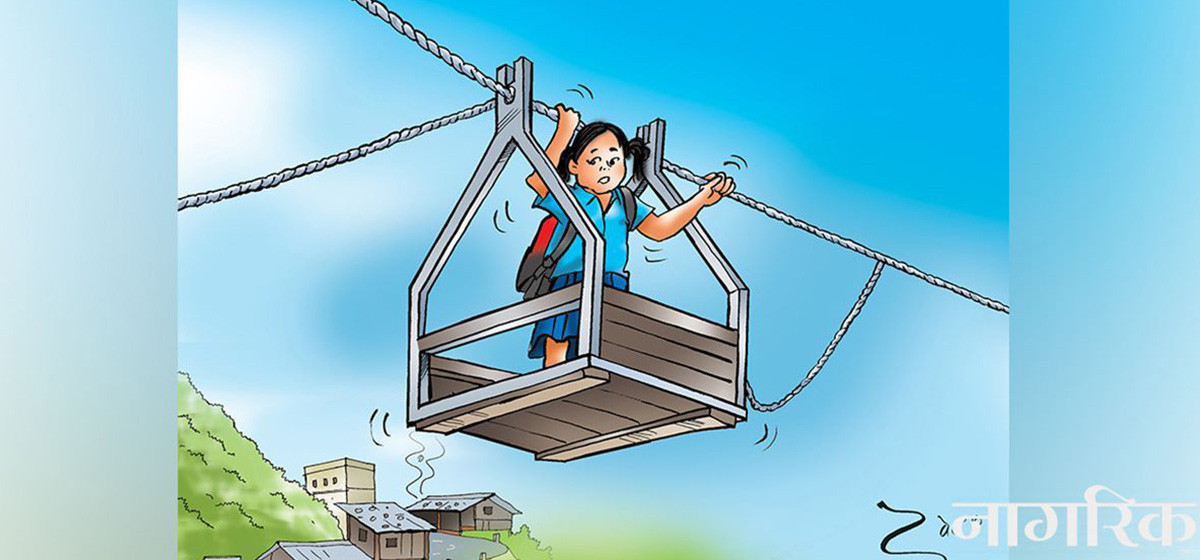KATHMANDU, May 4: After KP Sharma Oli assumed the post of Prime Minister for the first time on October 12, 2015, the very first decision made by his cabinet was to eliminate all tuins (ropeways used for river crossings) across the country within two years. However, nearly ten years later, this goal has not been achieved, although the government continues to list tuin removal as a priority on paper.
In the policies and programs presented by the government for the fiscal year 2025/26, the displacement of tuins has once again been given priority. While presenting the policies and programs at the joint session of the Federal Parliament on Friday, President Ram Chandra Paudel said, "To ease transportation in remote areas lacking road access, the displacement of tuins will continue through the construction of suspension bridges."
The responsibility for removing all tuins across the country has been given by the federal government to the Department of Local Infrastructure (DoLI), which operates under the Ministry of Urban Development. However, provincial and local governments also have the authority to remove tuins using their own budgets if they choose to do so. Despite this, none of the three tiers of government has been able to fully eliminate tuins from the country.
Some Tanahun villages still rely on tuin

DoLI Director General Mahesh Chandra Neupane admitted that the removal of tuins nationwide has not been achieved. "We still see photos and videos in various media showing tuins in use," he said. "Nonetheless, we are working with the removal of tuins as our top priority."
According to him, the total number of tuins across the country was confirmed at 143 in 2015 (2072 BS). Among those that have not yet been removed, one is located over the Karnali River within Bardiya National Park, and the other is over the Mahakali River at Pancheshwar Ghat.
"At Pancheshwar Ghat, removing the tuin and building a bridge requires the agreement of both Nepal and India. We had initiated the process to obtain India's consent through the Ministry of Foreign Affairs, but after failing to secure their approval, the tuin displacement program for that location was cancelled," said Neupane. "However, for the tuin over the Karnali River within Bardiya National Park, we have begun the displacement process. Currently, an environmental impact assessment is underway."
According to him, displacing a tuin means constructing a modern suspension bridge at the same location. "At present, we have received proposals to build suspension bridges at 5,500 locations across the country. However, these proposals do not explicitly state that there is a tuin at the site and that a suspension bridge is needed to replace it," he said.
He stated that even after 2015, reports have surfaced about tuins being constructed in various places, but the exact number is unknown. "Locals have built tuins based on their needs, but we haven't been officially informed about them. That's why we don't have a clear count of the tuins that still need to be removed," he said.
After the Oli government decided in 2015 to remove all tuins across the country, the government conducted a study and count of existing tuins. Following this, a Suspension Bridge Division was established under the Local Infrastructure Development Program (LIDP).
For tuin displacement, suspension bridges longer than 120 meters are constructed by the Suspension Bridge Division Office, while those shorter than 120 meters are built by the DoLI in coordination with Technical Support Units established under the provincial governments. Until 2024, DoLI coordinated with the respective District Coordination Committees, and the Trail Bridge Support Unit (TBSU) was responsible for building suspension bridges.
In 2024, however, the TBSU was dissolved. According to the Division Office, constructing suspension bridges in remote areas costs nearly twice as much as in accessible regions. As per DoLI, there are currently 11,400 suspension bridges across the country. Depending on the type of bridge, building a suspension bridge with towers can cost between Rs 100,000 to Rs 300,000 per meter, according to DoLI officials.



































